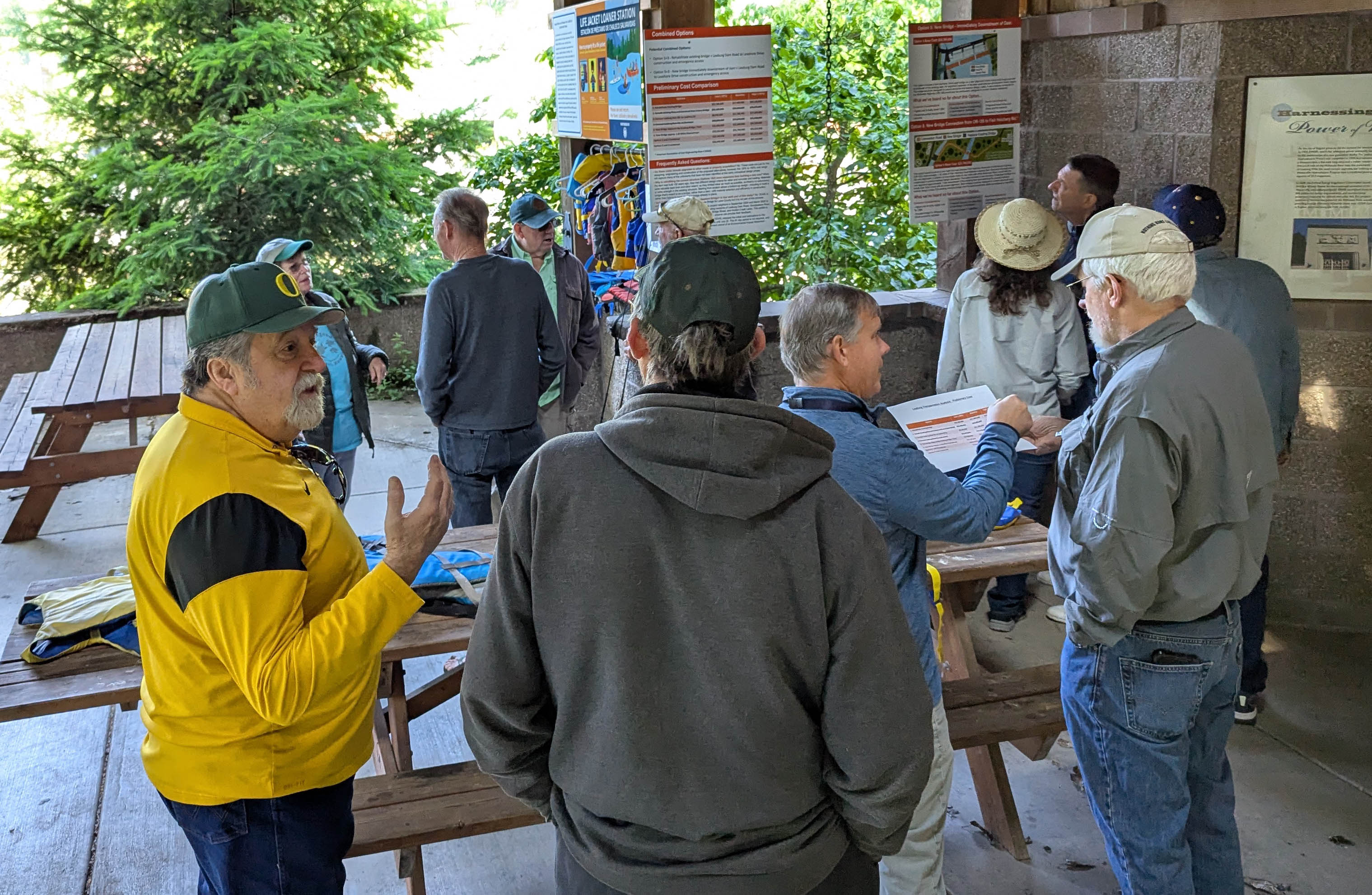Related News
Related News
-
Sustainability Snapshot - Celebrating Energy Efficiency Projects in the Community
Sustainability Snapshops highlight impactful projects completed by EWEB's Customer Solutions department, as a way to celebrate the meaningful work happening behind the scenes.
Find Out More -
McKenzie Valley electric service territory realignment study reaches key milestone
EWEB Commissioners approved a resolution authorizing the General Manager to negotiate and execute agreements with Lane Electric Cooperative regarding a potential realignment of electric service territory in the McKenzie Valley at the Board’s December meeting.
Find Out More -
EWEB secures $2.5 billion of reliable, affordable, carbon-free energy for customers
The new contract with EWEB’s largest energy supplier, the Bonneville Power Administration, forms the foundation of a diverse energy portfolio.
Find Out More -
Women in STEM: Meet the Hydro Project Engineer Building Habitat for Salmon
EWEB Engineer Associate Val Chang found her way to the McKenzie River from Los Angeles, inspired by heritage trips to the waters of Taiwan and key mentors along the way.
Find Out More -
Public Power Week Poster Contest Winners 2025
The results are in! View the winning posters from EWEB's 2025 Public Power Week Poster Contest.
Find Out More -
EWEB Hometown Heroes compete internationally
Out of 290 teams from 14 different countries, EWEB's Lineman Rodeo team places in the top third of competitors.
Find Out More -
EWEB's Halloween Truck-or-Treat is a huge success
Community members are accustomed to spotting EWEB trucks around Eugene streets and neighborhoods. But last week, those familiar vehicles looked a little different. At EWEB's second annual Truck-or-Treat Customer and Crew Appreciation Event, our fleet transformed into a festive Halloween spectacle.
Find Out More -
Let's Talk Turkey. Is your family ready for winter?
We're heading into the holidays, but that also means snow, ice, and not-so-nice weather might be in the forecast. Here are some tips to prepare in advance.
Find Out More -
Vote for your favorite Public Power Week Posters
The top five submittals will receive awards. Help us pick the winners.
Find Out More -
EWEB Hosts Annual Spill Drill to Protect McKenzie River
EWEB led emergency responders in its annual “spill drill” on the McKenzie River on Wednesday, Oct. 15, at the Trail Bridge Campground.
Find Out More -
Electric Projects underway in North & South Eugene
Underground lines and disaster-resilient power poles are part of EWEB’s infrastructure upgrade near Eugene’s largest natural resource area.
Find Out More -
EWEB general manager to retire in 2026
EWEB launches nationwide search for next leader to continue the progress of the last decade and ensure a smooth transition.
Find Out More -
The Bonneville Power Administration Rate Change and Your EWEB Bill
BPA’s finalized rate increase is smaller than projected, and EWEB’s pass-through adjustment effective October 1, 2025 will now be 2.7% for residential customers—down from the anticipated 4%.
Find Out More -
Quartz Creek: Setting the Stage for Floodplain Restoration
The project resets the floodplain along 1.8 miles of a formerly channelized creek to improve water quality, fish habitat and natural disaster resiliency.
Find Out More -
You can’t predict the next disaster, but you can prepare
The earthquake lasted less than a minute. But now the power’s out. The tap runs dry. Cell service is spotty. Would you be ready?
Find Out More - Show More
EWEB, Lane County host open house to gather feedback for “Leaburg Transportation Alternatives Analysis”
June 16, 2025 • Adam Spencer, Communications Specialist

With the decommissioning and eventual removal of the Leaburg Dam, the Eugene Water & Electric Board (EWEB) is collaborating with Lane County Public Works (LCPW) to explore options to maintain access from Highway 126 across the McKenzie River to Leaburg Dam Road.
EWEB, in coordination with LCPW, hired the engineering firm DOWL to lead a “Triple Bottom Line” evaluation of potential options. While the cost (traditionally called “the bottom line”) to implement the chosen solution will play a major factor in the decision, the social and environmental impacts are important considerations, too. A “Triple Bottom Line” decision seeks to balance these three major categories: Economics, Environment, Social Impacts.
DOWL has calculated the baseline costs to design and build several options to resolve this problem and is now soliciting feedback from community members on the social impacts each option could bring. Social impacts include safety, resiliency to major disruptions, recreational impacts, and livability.
EWEB hosted an open house on Saturday, June 14 at Lloyd Knox Park to share information and gather public feedback. About 40 people attended between 10 a.m. and 3 p.m.
Posters sharing information about the “Leaburg Transportation Alternatives Analysis” will be on display at the Lloyd Knox Park Visitor’s Pavilion until July 25 so park visitors can learn about each option and provide their feedback.
Community members are invited to learn more at eweb.org/leaburgbridge. Feedback can be submitted by calling EWEB Generation Planner Jeremy Somogye at 541-685-7439 or by emailing LeaburgInfo@eweb.org.
The public input session will close on July 25. Then, DOWL and subcontractor Parametrix will evaluate further engineering cost estimations and public feedback to compile a report to support decision makers by this fall.
Background
When EWEB built the Leaburg Dam in the early 1930s, it built a bridge on top so dam operators could access the south side of the McKenzie River to manage the facility.
What came to be known as Leaburg Dam Road extended beyond the EWEB property as the original Carol Lieberg property was subdivided into more than a dozen residential properties along the Leaburg Reservoir. In 1953, the Army Corps of Engineers built the Leaburg Hatchery on the east side of the river, connecting Fish Hatchery Road to thousands of acres of private timber lands and Whitewater Ranch – a historic farm that produces blueberries today.
With the decommissioning of the Leaburg Hydroelectric Project – due primarily to the prohibitively high costs to address structural issues throughout the Leaburg Canal – EWEB will no longer be able to provide the beneficial use of the bridge for the neighborhood.
Now the primary question the Triple Bottom Line aims to inform is: “What is the Future of the Leaburg Dam Bridge?”
Should there be a new bridge in the same location? Should these roads be connected to nearby bridges? Can the concrete piers of the dam be modified and remain in the river to continue to support a bridge? Are there better locations for a bridge? What are the costs? How will the community and the environment be impacted by these options?
Proposed Options
EWEB, in coordination with Lane County, hired the engineering firm DOWL to assess several options:
- Option 1: Restore the existing Leaburg Dam Road Bridge (the steel part and roadway surface above the dam roll gates) to an improved standard for ongoing functionality.
- Option 2: Replace the existing bridge spans and superstructure (the steel part and roadway surface) in its current location while using or modifying the existing sub-structure (the concrete structures in the water).
- Option 3: Permanently remove the existing bridge and develop a connection between Leaburg Dam Road and Goodpasture Bridge via Leashore Drive.
- Option 4: Permanently remove the existing bridge and develop a connection between Leaburg Dam Road and Deerhorn Road providing access to Bridge Street Bridge and Holden Creek Lane.
- Option 5: Remove and replace the existing bridge with new bridge in its current location.
- Option 6: Permanently remove the existing bridge and build a new bridge off of Fish Hatchery Road to connect to Highway 126 via Evans Lane over the Leaburg Canal. (The DOWL team developed this additional option after seeing the lay of the land).
Baseline Cost Estimates
DOWL prepared baseline cost estimations to design and construct each option. The cost estimations do not include other costs that may occur (such as purchasing easements to cross or to permanently own properties, if needed) to build a chosen alternative.
The high costs to build Option 2 and Option 4 made them too expensive to merit further exploration.
DOWL also calculated the costs to combine Option 3 with the other options that would keep a bridge connecting Leaburg Dam Road to Highway 126. The purpose would be to provide connectivity for emergency evacuations should a wildfire, earthquake or other disaster incapacitate the Goodpasture Bridge:

Outreach
EWEB and Lane County have been communicating primarily with the residents most-impacted by this decision. Residents of Leaburg Dam Road, Fish Hatchery Road, Leashore Drive, Goodpasture Road, Deerhorn Road, and Holden Creek Lane received letters in September 2024 and in March of this year to inform them of the study and initial baseline cost estimations.
Residents were also invited to a May 5 virtual meeting to go over each proposed option and the costs to kick-off the gathering of public feedback.
EWEB updated community members at the May 15 McKenzie Valley Customer Appreciation Dinner at the Walterville Community Center. Leading up to Saturday’s open house, EWEB promoted the event with an advertisement in the McKenzie River Reflections and social media posts.
Anyone with questions or to provide their feedback can go to eweb.org/leaburgbridge, call EWEB Generation Planner Jeremy Somogye at 541-685-7439, or email LeaburgInfo@eweb.org.

